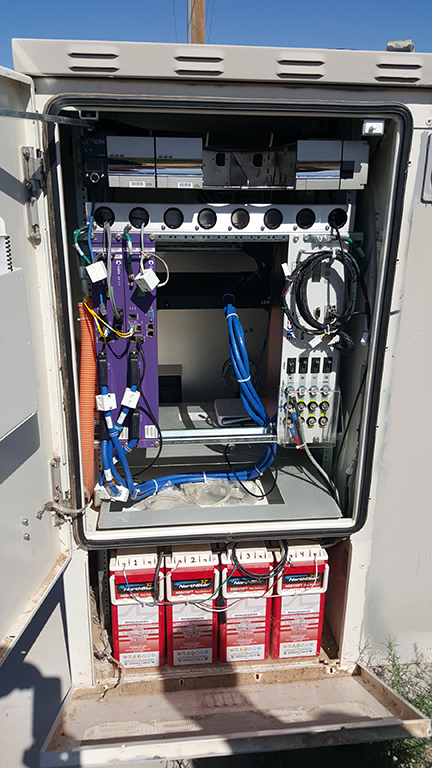Adaptive Charging: The Inefficiencies of Continuous Float Charging (Part 1 of 4)
This article originally appeared in the 2Q17 edition of Battery Power Magazine. The article is published on our blog in 4 parts. You can access the full article here.
The accelerating growth of Internet of Things (IoT) devices and applications require continuous investment in telecommunications networks to provide the connectivity for millions of new devices. As more devices connect to the Internet, service outages become more impactful to the people and businesses that rely on IoT applications. Safeguarding telecom networks from power outages is the Valve Regulated Lead Acid (VRLA) battery. Stationary VRLAs are ubiquitously used at broadband, wireless and cable sites, and millions are in service across the country. Unfortunately, almost all of these batteries, and thus the sites that depend on them, are vulnerable to a reliability-damaging standard: float charging. While float charging will maintain batteries at full charge, it can have a damaging impact on the service life of the battery, which introduces risk and increases maintenance costs. There is a better way to charge batteries, Adaptive Charging, that mitigates the degrading effects of float charge, extending battery life and reducing maintenance costs.

Figure 1: Batteries in a small Outside Plant Cabinet
Inefficiencies of Continuous Float Charging
Before describing the inefficiencies of continuous float charge and VRLA maintenance inefficiencies, it’s important to understand why VRLAs are, and will remain, the battery of choice for telecom outside plant deployments. Though the trade off has reduced the service life of VRLAs compared to their flooded counterparts, the elimination of watering has been a major improvement for battery maintenance. Most importantly, VRLAs are cheap and generally reliable. Lithium Ion, Ni-Cd, and other chemistries simply cannot top the convenience of VRLAs. The telecom industry is not looking to change the batteries it orders or the power engineering of its sites anytime soon.
But every technological step involves some give and take and it seems with batteries this is a particularly dependable axiom. VRLAs are sealed and thus the heat generated by an exothermic gas recombination mechanism is trapped inside the battery and can only be removed by transmission through the container walls. Continuous float charging generates continuous heat within the batteries. The heat levels are exacerbated by closely packed batteries in telecom installations and the likelihood of high temperatures found in metal cabinets that sit in the sun all day.
Higher internal battery temperatures accelerate failure. A cabinet like the one on the right could routinely reach temperatures in excess of 60°C during the summer, and a “10-year” battery with a true expected life of four to six years may only deliver 2 years of service.
All this heat from oxygen recombination, hot summer temperatures and poor air circulation in the cabinets, drives up the rate of battery degradation, and thus the risk of network failure when the batteries are not sufficient to provide backup power. Increased battery temperature from gas recombination accelerates:
- Grid Corrosion
- Dehydration
- Dry-Out
In addition, active material degradation and capacity loss take place as a result of:
- Plate Softening
- Loss of Cohesion
While continuous float charging is a sufficient way to maintain fully charged batteries, the relentless heat generation introduces risk to the system by accelerating battery failure. This means maintenance trips are required much more often (when there is capacity for the workforce to absorb the extra trips), driving up cost. Often there are not enough workers to test and replace the batteries and the failed batteries remain in the field for months or even years. Today, most telecommunications companies rely on cyclical maintenance that may involve checks as frequently as every few months, but they can happen as infrequently as once a year.
These long periods of time without a site check mean that battery health readings provide limited insight into true battery health. If a plant manager or network technician does not have enough battery data, he or she cannot make predictions about battery life and will find it impossible to take proactive steps to protect reliability. Further, equipment failures of other kinds such as fans, heat exchangers or rectifiers can end up damaging batteries in other ways not related to a continuous float charge. If the charging regimen could be changed, many of these inefficiencies could be reduced or eliminated and reliability could be improved.
Part 2 of 4 of the article will be published soon.
About Servato
Headquartered in New Orleans, LA, Servato is a leading provider of active battery management solutions to telecom, power, transportation, and solar companies. Servato’s solutions allow leading companies and infrastructure operators to reduce CapEx and OpEx by extending battery life, reducing maintenance costs and streamlining operations. Utilizing highly accurate data, proprietary algorithms, adaptive charging and cloud-based visualization software, Servato provides unprecedented insight and control over distributed DC power assets in industrial settings. To learn more, please visit: www.servatocorp.com











